Articles
- Page Path
- HOME > J Korean Acad Nurs > Volume 39(3); 2009 > Article
-
Original Article
- Analyses of Studies on Cardiac Rehabilitation for Patients with Cardiovascular Disease in Korea
- Yeoungsuk Song
-
Journal of Korean Academy of Nursing 2009;39(3):311-320.
DOI: https://doi.org/10.4040/jkan.2009.39.3.311
Published online: June 29, 2009
Post Doctoral Fellow, School of Nursing, University of Minnesota, Minneapolis, MN, USA.
- Address reprint requests to: Song, Yeoungsuk. School of Nursing, University of Minnesota, 5-140 Weaver-Densford Hall, 308 Harvard Street, Minneapolis, MN 55455, USA. Tel: 1-612-203-8248, Fax: 1-612-625-7180, asansong@hanmail.net
Copyright © 2009 Korean Society of Nursing Science
Abstract
-
Purpose
- This study was to analyze research reports published in Korea on cardiac rehabilitation for patients with cardiovascular disease.
-
Methods
- Based on inclusion criteria, 19 research reports were included in this review. Published year of selected articles was between 1996 and 2008. Nineteen studies were analyzed by guidelines of the cardiac rehabilitation programs done by the American Heart Association (AHA) and Scottish Intercollegiate Guidelines Network (SIGN).
-
Results
- The characteristics of patients were mostly of ischemic heart disease, 50-59 yr old, and male. Educational sessions were administered twice, and each lesson lasted less than 30 min. Exercise was done 3 times per week for 6 weeks. Most educational content were about risk factors, but there was no information, such as coping with feelings. Most exercise was performed as ROM, treadmill, and cycle ergometer. A large percentage of outcome indicators were health behavior, hemodynamic changes, and exercise capacity. There was more 'no effect' than 'positive effect' in trait anxiety and depression, whereas similar in physiologic domain.
-
Conclusion
- Various types of cardiac rehabilitation in Korea were performed by researchers. Therefore, we need to develop the standard protocol, to add psychosocial intervention, and to study cost effectiveness of cardiac rehabilitation.
- 1. Ahn JK. The effectiveness of cardiac rehabilitation on exercise capacity, ventricular function and changes of coronary artery in patients with ischemic heart disease. 2004;Seoul, Yonsei University. Unpublished master's thesis.
- 2. Cardiac rehabilitation. American Heart Association. 2009;01 01 Retrieved March 28, 2009. from http://www.americanhe.art.org/presenter.jhtml?identifier=3047638.
- 3. Balady GJ, Williams MA, Ades PA, Bittner V, Comoss P, Foody JM, et al. Core components of cardiac rehabilitation/secondary prevention programs: 2007 update. Circulation. 2008;115:2675–2682.Article
- 4. Bang I. Exercise response in coronary artery disease with beta blockers during phase II cardiac rehabilitation. 2003;Seoul, Yonsei University. Unpublished master's thesis.
- 5. Bang I, Kim C, An J. Cardiac rehabilitation effect in view of rating of perceived exertion. Inje Medical Journal. 2002;23:547–552.
- 6. Bartels MN, Whiteson JH, Alba SA, Kim H. Cardiopulmonary rehabilitation and cancer rehabilitation. Archives of Physical Medicine & Rehabilitation. 2006;87:S46–S56.
- 7. Brorsson B, Bernstein SJ, Brook RH, Werko L. Quality of life of patients with chronic stable angina before and four years after coronary revascularization compared with a normal population. Heart. 2002;87:140–145.PubMedPMC
- 8. Cho HS. The effects of a cardiac rehabilitation program for the patients with ischemic heart disease. 1999;Seoul, Kyunghee University. Unpublished doctoral dissertation.
- 9. Cohen J. Statistical power analysis for the behavioral sciences. 1988;Hillsdale, NJ, Lawrence Erlabum Associates Inc.
- 10. Choo JA. Cardiac Rehabilitation. 2003a;04;In: Paper presented at the meeting of the Korean Academy of Adult Nursing; Seoul.
- 11. Choo JA. Effects of TES program on exercise capacity, self-efficacy and patient compliance in patients with myocardial infarction. Journal of Korean Academy of Nursing. 2003b;33:905–916.ArticlePubMedPDF
- 12. Choo JA. Effects of TES (Training, Efficiency & Support) program in cardiac rehabilitation for patients with myocardial infarction. 2003c;Seoul, Seoul National University. Unpublished doctoral dissertation.
- 13. Choo JA, Hong KP, Jae SY, Hong SH, Park WH, et al. Effects of cardiac rehabilitation in patients with myocardial infarction. Korean Circulation Journal. 1997;27:342–349.Article
- 14. Doh JH, Choo JA, Kim YH, Oh HL, Kim PH, Ahn SJ, et al. The effect of cardiac rehabilitation on physiologic and inflammatory markers in patients with acute myocardial infarction. Korean Circulation Journal. 2004;34:820–827.
- 15. Duncan AM, Francis DP, Gibson DG, Henein MY. Limitation of exercise tolerance in chronic heart failure: Distinct effects of left bundle-branch block and coronary artery disease. Journal of the American College of Cardiology. 2004;43:1524–1531.ArticlePubMed
- 16. Dusseldorp E, van Elderen T, Maes S, Meulman J, Kraaij V. A meta-analysis of psychoeducational programs for coronary heart disease patients. Health Psychology. 1999;18:506–519.ArticlePubMed
- 17. Grossman P, Niemann L, Schmidt S, Walach H. Mindfulness based stress reduction and health benefits. Journal of Psychosomatic Research. 2004;57:35–43.ArticlePubMed
- 18. Health Plan 2010 focus area. Health Plan 2010. 2006;02 01 Retrieved November 3, 2008. from http://2010.hp.go.kr/intro/intro_3.aspx.
- 19. Herridge ML, Stimler CE, Southard DR, King ML. Depression screening in cardiac rehabilitation. Journal of Cardiopulmonary Rehabilitation. 2005;25:11–13.Article
- 20. Hong KH. The outcomes of cardiac rehabilitation program in the post myocardial infarction patient. 1996;Seoul, Kyunghee University. Unpublished master's thesis.
- 21. Jung HS. Effects of a cardiac rehabilitation program on health behavior and physiologic parameters for myocardial infarction patients. 2001;Seoul, Catholic University. Unpublished doctoral dissertation.
- 22. Jung YS. Effects of phase I cardiac rehabilitation program on self-efficacy and performance of health behavior in acute myocardial infarction patients. 2002;Seoul, Seoul National University. Unpublished master's thesis.
- 23. Kim C, Ahn JK, Bang IK, Kim YJ. Effect and safety of cardiac rehabilitation program in heart failure. Journal of Korean Academy of Rehabilitation Medicine. 2005;29:92–97.
- 24. Kim C, Ahn JK, Bang IK, Rhee KJ, Kim BO, So MC, et al. Effectivess of the cardiac rehabilitation on exercise capacity and risk factor in coronary artery obstructive disease. Journal of Korean Academy of Rehabilitation Medicine. 2006;30:74–79.
- 25. Kim NC, Choi KO. The effect of individualized cardiac rehabilitation education for percutaneous coronary intervention (PCI) patients. Journal of Korean Academy Fundamental Nursing. 2006;13:42–49.
- 26. Kim SY. The effects of a cardiac rehabilitation educational program on anxiety, health compliance and quality of life of the patient with cardiac valve replacement. The Korean Journal of Rehabilitation Nursing. 1999;2:153–162.
- 27. Konstance RP, Eisenstein EL, Anstrom KJ, Shaw LK, Califf RM, Harrington RA, et al. Outcomes of second revascularization procedures after stent implantation. Journal of Medical System. 2008;32:177–186.ArticlePDF
- 28. Kop WJ, Weissman NJ, Zhu J, Bonsall RW, Doyle M, Stretch MR, et al. Effects of acute mental stress and exercise on inflammatory markers in patients with coronary artery disease and healthy controls. Journal of the American College of Cardiology. 2008;101:767–773.Article
- 29. Statistics of causes of death. Korea National Statistical Office. 2008;09 10 Retrieved October 14, 2008. from http://www.kosis.kr/search/totalSearch2.jsp.
- 30. Cardiopulmonary resuscitation. Korean Society Circulation. 2006;10 25 Retrieved June 24, 2008. from http://www.circulation.or.kr/eoffice/notice/view_article.php?code=notice&number=325.
- 31. Lee HR. The effect of phase 1 cardiac rehabilitation nursing care on knowledge, anxiety and self-care behavior in patients with acute myocardial infarction. 1998;Daegu, Keimyung University. Unpublished master's thesis.
- 32. Lee HR. Effects of relaxing music on stress response of patients with acute myocardial infarction. Journal of Korean Academy of Nursing. 2003;33:693–704.ArticlePubMedPDF
- 33. Lee JS. Development and evaluation of cardiac rehabilitation program for coronary artery bypass grafting patients. 2008;Seoul, Seoul National University. Unpublished doctoral dissertation.
- 34. Lee YS. The effect of cardiac rehabilitation education on selfcare knowledge and self-care behavior in open heart surgery patients after hospital discharge. 2003;Busan, Dongeui University. Unpublished master's thesis.
- 35. Leon AS, Franklin BA, Costa F, Balady GJ, Berra KA, Stewart KJ, et al. Cardiac rehabilitation and secondary prevention of coronary heart disease. Circulation. 2005;113:369–376.
- 36. Monpere C. Cardiac rehabilitation: Guidelines and recommendation. Dis Manage Health Outcomes. 1998;4:143–156.
- 37. Praissman S. Mindfulness-based stress reduction: A literature review and clinician's guide. Journal of the American Academy of Nurse Practitioners. 2008;20:212–216.ArticlePubMed
- 38. Rozanski A, Blumenthal JA, Kaplan J. Impact of psychological factors on the pathogenesis of cardiovascular disease and implications for therapy. Circulation. 1999;99:2192–2217.ArticlePubMed
- 39. Cardiac rehabilitation. Scottish Intercollegiate Guidelines Network. 2002;01 31 Retrieved September 3, 2008. from http://www.sign.ac.uk/guidelines/fulltext/57/index.html.
- 40. Seematter G, Binnert C, Tappy L. Stress and metabolism. Metabolic Syndrome & Related Disorders. 2005;3:8–13.Article
- 41. Song KJ. The effects of self-efficacy promoting cardiac rehabilitation program on self-efficacy, health behavior, and quality of life. 2001;Seoul, Seoul National University. Unpublished doctoral dissertation.
- 42. Song RY, Lee HJ. Effects of the inpatient cardiac rehabilitation program on behavioral modification and quality of life in patients with coronary artery disease. Journal of Korean Academy of Nursing. 2000;30:463–475.ArticlePDF
- 43. Song YS, Lee JS. A comparison of quality of life between patients with 12 months after coronary artery bypass graft surgery and general population. Journal of Korean Clinical Nursing Research. 2008;14:27–34.
- 44. Stirrat C, Mann S. Perceptions of cardiovascular risk factors among cardiology outpatients. Heart, Lung & Circulation. 2008;17S:S22–S23.
- 45. Tierney JR, Lawrence M. Current medical diagnosis & treatment. 2007;New York, NY, McGraw Hill.
- 46. Vlastelica M. Emotional stress as a trigger in sudden cardiac death. Psychiatria Danubina. 2008;20:411–414.PubMed
- 47. Yohannes AM, Yalfani A, Doherty P, Bundy C. Predictors of drop-out from an outpatient cardiac rehabilitation programme. Clinical Rehabilitation. 2007;21:222–229.ArticlePubMedPDF
REFERENCES
Figure & Data
REFERENCES
Citations

- Comprehensiveness of cardiac rehabilitation program in Korea: a nation-wide survey result
Jidong Sung, Chul Kim, Jae-Young Han, Sungju Jee, Jang Woo Lee, Jong Hwa Lee, Won-Seok Kim, Heui Je Bang, Sora Baek, Kyung-Lim Joa, Ae Ryoung Kim, So Young Lee, Jihee Kim, Chung Reen Kim, Oh Pum Kwon
BMC Cardiovascular Disorders.2023;[Epub] CrossRef - Reliability and Validity of Korean-Version of Information Needs in Cardiac Rehabilitation Scale
Sang Young Heon Choi, Joong Hwi Kim
The Journal of Korean Physical Therapy.2022; 34(5): 234. CrossRef - Medium reach theory for nursing in cardiovascular rehabilitation
Maria Sinara Farias, Lúcia de Fátima da Silva, Marcos Antônio Gomes Brandão, Maria Vilani Cavalcante Guedes, Keila Maria de Azevedo Pontes, Rafael Oliveira Pitta Lopes
Revista Brasileira de Enfermagem.2021;[Epub] CrossRef - The Effect of Depression on Aggression in Patients with Coronary Artery Disease
Jae-Hee Lee
The Korean Journal of Rehabilitation Nursing.2019; 22(1): 67. CrossRef - Effect of Cardiac Rehabilitation on Quality of Life, Depression and Anxiety in Asian Patients
Carol C. Choo, Peter K. H. Chew, Shuet-Ming Lai, Shuenn-Chiang Soo, Cyrus S. Ho, Roger C. Ho, Raymond C. Wong
International Journal of Environmental Research and Public Health.2018; 15(6): 1095. CrossRef - Development and Effectiveness of Tailored Education and Counseling Program for Patients with Coronary Artery Disease undergoing Percutaneous Coronary Intervention
So-Yeon Kim, Min Young Kim
Korean Journal of Adult Nursing.2017; 29(5): 547. CrossRef - Biomarker for the Prediction of Major Adverse Cardiac Events in Patients with Non-ST-Segment Elevation Myocardial Infarction
Ho Sun Shon, Jang-Whan Bae, Kyoung Ok Kim, Eun Jong Cha, Kyung Ah Kim
Osong Public Health and Research Perspectives.2017; 8(4): 237. CrossRef - Prognostic role of NT-proBNP (N-terminal pro-brain natriuretic peptide) in patients with non-ST-segment elevation myocardial infarction: analysis based on propensity score matching and weighting
Ho Sun Shon, Jang Whan Bae, Kyoung Ok Kim, Eun Jong Cha, Kyung Ah Kim
Journal of Biomedical Translational Research.2017; 18(3): 67. CrossRef - Inpatient cardiac rehabilitation programs’ exercise therapy for patients undergoing cardiac surgery: National Korean Questionnaire Survey
Yong Gon Seo, Mi Ja Jang, Won Hah Park, Kyung Pyo Hong, Jidong Sung
Journal of Exercise Rehabilitation.2017; 13(1): 76. CrossRef - Mindfulness Meditation Experiences among Patients with Coronary Artery Disease: A Phenomenological Study
Yeoungsuk Song, Taeyun Song, Jong Young Lee, Young Sook Yoo, So-Hi Kwon
Korean Journal of Adult Nursing.2015; 27(1): 21. CrossRef - Effects of a comprehensive cardiac rehabilitation program in patients with coronary heart disease in Korea
So‐Sun Kim, Sunhee Lee, GiYon Kim, Seok‐Min Kang, Jeong‐Ah Ahn
Nursing & Health Sciences.2014; 16(4): 476. CrossRef - Effects of a psychoeducational intervention for secondary prevention in Korean patients with coronary artery disease: A pilot study
Jin‐Hee Park, Seung‐Jae Tahk, Sun Hyoung Bae, Youn‐Jung Son
International Journal of Nursing Practice.2013; 19(3): 295. CrossRef - N-terminal pro-B-type natriuretic peptide as prognostic marker for patients of non ST-segment elevation myocardial infarction
Ho Sun Shon, Kyung Kuk Hwang, Jang Whan Bae, Kyung Ah Kim, Jong Yun Lee, Keun Ho Ryu
Journal of Central South University.2013; 20(8): 2226. CrossRef - Learning needs of patients with heart failure a descriptive, exploratory study
So‐Sun Kim, Jeong‐Ah Ahn, Seok‐Min Kang, GiYon Kim, Sunhee Lee
Journal of Clinical Nursing.2013; 22(5-6): 661. CrossRef - Analysis of Nursing Intervention Studies on Patients with Breast Cancer in Korea
Kyung Sook Choi, Mi Sook Kim, In Ja Lee, Sang Young Han, Jung Ae Park, Joohyun Lee
Journal of Korean Oncology Nursing.2011; 11(1): 74. CrossRef - An Analysis of Articles for International Marriage Immigrant Women Related to Health
Ok-Hee Ahn, Mi-Soon Jeon, Yoon-Young Hwang, Kyung-Ae Kim, Mi-Sun Youn
Journal of agricultural medicine and community health.2010; 35(2): 134. CrossRef - Comparison of Cardiovascular Health Status and Health Behaviors in Korean Women based on Household Income
Young-Joo Park, Nah-Mee Shin, Ji-Won Yoon, Jiwon Choi, Sook-Ja Lee
Journal of Korean Academy of Nursing.2010; 40(6): 831. CrossRef
Characteristics of Patients in 19 Research Papers (N=19)
MI=myocardial infarction; UA=unstable angina; CABG=coronary artery bypass graft; MVR=mitral valve replacement; VSD=ventricular septal defect patch closure; PCI=percutaneous coronary intervention; HF=heart failure.
Analysis of Cardiac Rehabilitation Protocol (N=19)
*Multiple responses.
Analysis of Content on Educational Intervention in Cardiac Rehabilitation (N=13)
*Multiple responses.
Analysis of Content on Exercise Intervention in Cardiac Rehabilitation (N=13)
*Multiple responses; METs=metabolic equivalent.
Outcome Indicators and Effects in Cardiac Rehabilitation (N=19)
*Multiple responses.
MI=myocardial infarction; UA=unstable angina; CABG=coronary artery bypass graft; MVR=mitral valve replacement; VSD=ventricular septal defect patch closure; PCI=percutaneous coronary intervention; HF=heart failure.
*Multiple responses.
*Multiple responses.
*Multiple responses; METs=metabolic equivalent.
*Multiple responses.
 KSNS
KSNS
 E-SUBMISSION
E-SUBMISSION
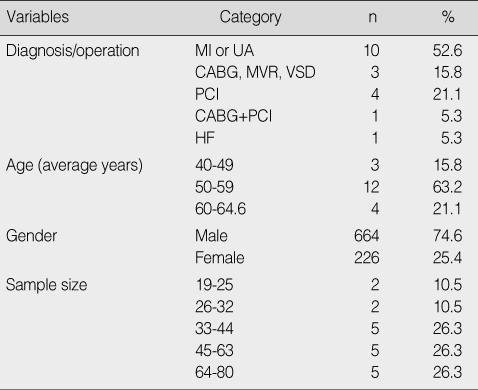
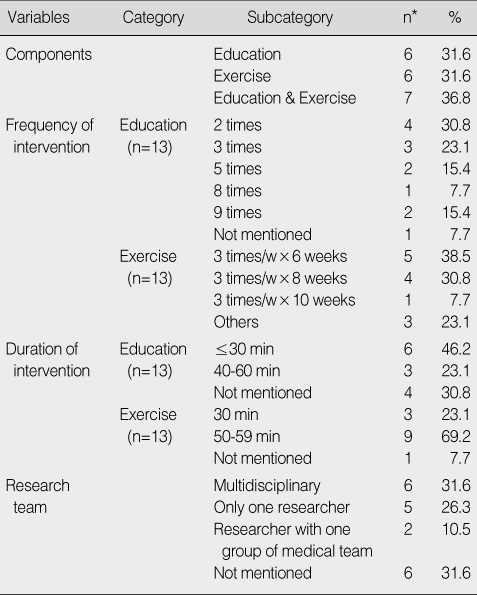
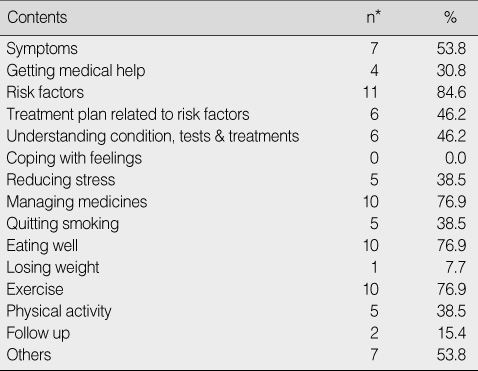
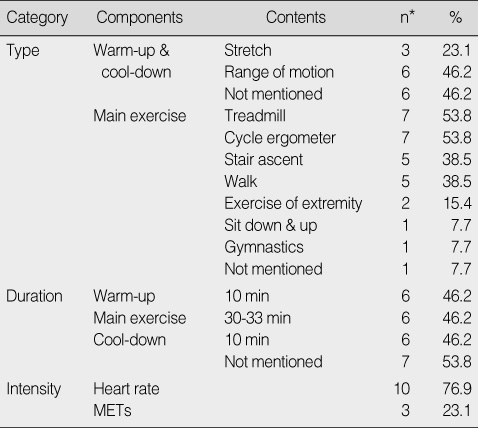
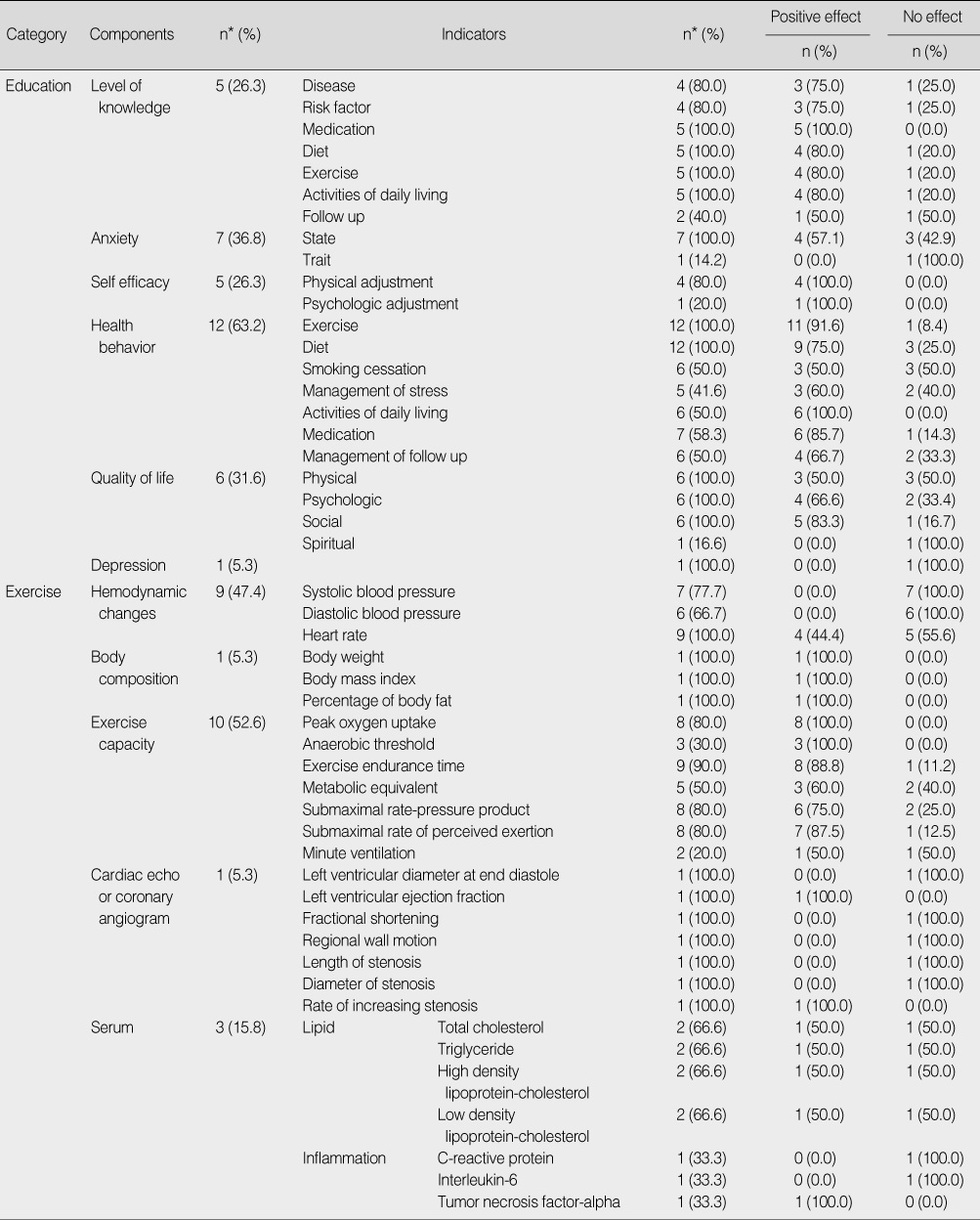
 Cite
Cite

